Final report for LS16-268
Project Information
Cooperators
- - Producer
- (Educator)
- - Producer
- (Educator)
- - Producer
- (Educator and Researcher)
- - Producer
- (Educator)
- (Educator and Researcher)
- (Educator and Researcher)
- (Educator and Researcher)
- (Educator)
- - Producer (Educator)
Research
In 2016, production of leafy vegetables under row cover and insect netting was investigated in comparison to open field at four locations (one organic and two conventional on-farm, and on-station) to satisfy objectives 1 and 2.
- Eastern Shore AREC. Leafy vegetables were planted in March, May and August, 2016 to determine the interaction of mulch color (black and white) and low tunnel (row cover and insect net) in beds with drip irrigation. In addition, the incidence of pest damage was determined between cover and non-covered plots without pesticide applications. The experimental design was a split plot with mulch as the main effect and low tunnel as the second effect with three replications. All crops were transplanted (greenhouse grown transplants) and covered immediately. Crops included lettuce, Swiss chard and kale.
- Eastern Shore AREC spring cucumber. Eureka, Excelsior and Picolino cucumbers were planted in mid-April to determine the benefit of using row cover in the spring. Experimental design was a split-split plot design with mulch color (white and black) as the main effect, row cover as the second effect and cultivar as the third effect with three replications.
- Eastern Shore AREC summer cucumber. A study with cucumbers (planted in early June) was set up to determine the optimal time to remove the cover in summer (0, 2, 4, and 6 weeks after planting). Experimental design was a complete block design, with four replications.
To engage vegetable farmers into experiencing first-hand the outcomes of using row cover and insect netting in spring, summer and fall/winter, the project implemented on-farm studies with participating farmers (objective 4). These studies were selected by the participating farmers and reflect their interest in solving their particular problems:
- Lois’s Produce in Westmoreland Co., VA changed their crop interest to tested row cover (low tunnel) on okra under drip irrigation and black mulch. They covered 500ft of okra for 4 weeks and compared the yield of the first harvest to uncovered plants (Fig. 1).
- Blenheim Organic Gardens in Westmoreland Co., VA. used row cover and insect nets to reduce insect pressure in summer squash and lettuce (Fig. 2 and 3).
In 2017, the benefits of row covers and insect netting were investigated in comparison to open field through on-farm and on-station studies to satisfy objectives 2 and 3 of this project.
- Insect netting on flea beetle (Fig. 4). To evaluate the efficacy of deltamethrin-impregnated screen, two field experiments and a bioassay were conducted. On May 26th 2016 and June 6th 2017 both six week old ‘Bravo’ cabbage and eight week old ‘Classic’ eggplant transplants were planted in Whitethorne Virginia. For the field experiments, a five treatments test with six replicates per treatment per crop was applied to five transplants per crop, set up in a completely randomized design. Treatments included: an untreated control consisting of five transplants by themselves, a soil applied neonicotinoid dinotefuran, an open ended screen row cover made from ordinary window screen, a screen row cover made from black deltamethrin incorporated screen, and a screen row cover made from yellow deltamethrin incorporated screen. Plots consisted of single 3.048m long rows spaced 0.91m apart, with cabbage planted ~38 cm apart and eggplant planted 0.46m apart within rows. Once a week over a five week period each treatment was evaluated by counting the number of live beetles on three randomly selected plants per plot. At the same time plants in each treatment were also evaluated by assessing the defoliation of five randomly selected leaves per plot. Each leaf was placed in one of five defoliation categories: 0%, 1-20%, 21-40%, 41-60%, and >60%. Lastly, yield was taken at harvest to determine if the treatments had an effect on yield. After the five week assessment period, all screen row cover treatments were removed to keep from stifling plant growth, and a long lasting broad spectrum insecticide Voliam Xpress®, lambda-cyhalothrin and chlorantraniliprole, Syngenta® Switzerland, was applied to all plants to ensure further insect injury does not affect yield. At the time of harvest yield was assessed by weighing three cabbage heads, and eggplant was assessed by weighing and counting the total number of eggplant produced. The mean number of live beetles per treatment was analyzed as well as the mean percent defoliation among each treatment. All data were analyzed using analysis of variance procedures. Means were separated using Fisher’s LSD at the 0.05 level of significance.
- Water requirements and use efficiency (WUE) (Fig. 5). Conducted first season study to determine differences in irrigation water requirement and water use efficiency in spring production of Brussels sprouts under row cover and open field. Brussels sprouts var. ”Dimitri” was planted on 12 April 2017 in a split plot experimental design with mulch color (black and white) as the main effect (plot) and row cover (1 oz/yd2) as the secondary effect (subplot), and four replications. Treatments and experimental units were monitored for micro-environmental conditions and soil moisture. Plants were drip-irrigated based on soil moisture and an irrigation event was initiated at 50% deficit of the plant available water. The amount of water applied (irrigation time) was estimated to bring soil moisture in the root zone to field capacity. Evapotranspiration under row covers was compared with open field. Plant height, number of sprouts and weight were recorded to determine differences in growth and yield.
- Nutrient optimization and use efficiency (NUE) (Fig.6). Conducted first season study to determine differences in N requirement and use efficiency in basil (var. “Eleonora”) summer production under row cover compared to open field. The experimental design was a split plot with four replications. The main effect (plots) was N fertilizer rate (0, 37, 74, 111, 148, and 185 Kg∙ha-1) and the secondary effect (subplots) was low tunnel covered with spun-bonded row cover (0.5 oz/yd2) and no cover. Plants were drip-irrigated daily. Plant height, fresh yield and biomass were measured at 30, 60, and 85 days after planting to determine differences in growth and production.
To engage vegetable farmers into experiencing first-hand the outcomes of using row cover and insect netting in spring, summer and fall/winter, the project implemented on-farm studies with participating farmers (objective 4). These studies were selected by the participating farmers and reflect their interest in solving their particular problems:
- Bill Jardine at Quail Cove Farm tested spring production of sweetpotato slips under row cover as an alternative to high tunnel production (Fig. 7).
- Lois’s Produce in Westmoreland Co., VA tested row cover (low tunnel) on okra (second year) and summer squash under drip irrigation and black mulch. They covered 500ft each for 4 weeks and compared the yield of the first two harvests after uncovering the plants (Fig. 8).
- Lawrence and Becky Latane at Blenheim Organic Gardens in Westmoreland Co., VA used row cover and insect nets to reduce insect pressure in leafy vegetables (Fig. 9).
- Garner Boyle at Garner’s Produce, tested rowcover on late spring cucumbers for 4 weeks after planting to increase growth and protect against insects (Fig. 10).
In 2018-19, second year experiments on the benefits of row covers in comparison to open field were completed to satisfy objectives 1 and 3 of this project.
- Water requirements and use efficiency (WUE). Conducted second season study to determine differences in irrigation water requirement and water use efficiency in spring production of Brussels sprouts under row cover and open field. Plants were drip-irrigated based on soil moisture and an irrigation event was initiated at 50% deficit of the plant available water. The amount of water applied (irrigation time) was estimated to bring soil moisture in the root zone to field capacity. Evapotranspiration under row covers was compared with open field. Plant height, number of sprouts and weight were recorded to determine differences in growth and yield.
- Nitrogen optimization and use efficiency. Conducted first season study to determine differences in N requirement and use efficiency in basil (var. “Eleonora”) summer production under row cover compared to open field. Plant height, fresh yield and biomass were measured periodically to determine differences in growth and production.
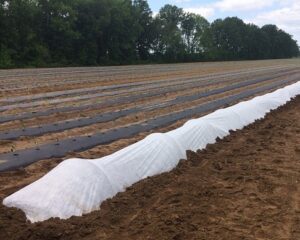
Figure 1. Lois's Produce, okra under row cover. May 2016
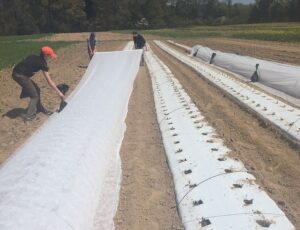
Figure 2. Blenheim Organic Gardens, lettuce, April 2016
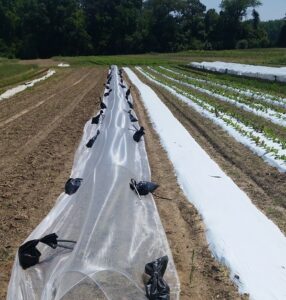
Figure 3. Blenheim Organic Gardens, insect net, May 2016
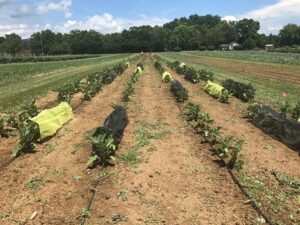
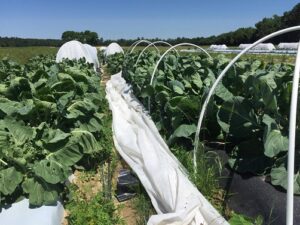
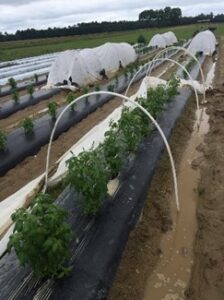
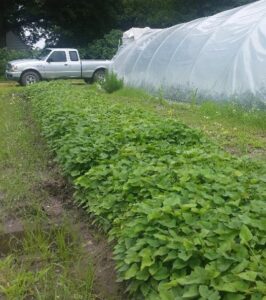
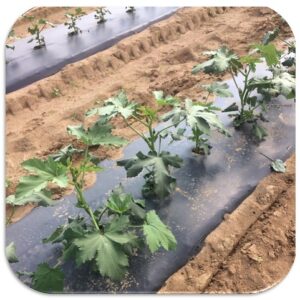
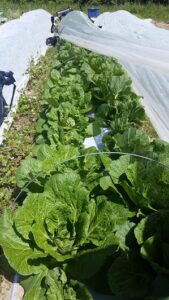
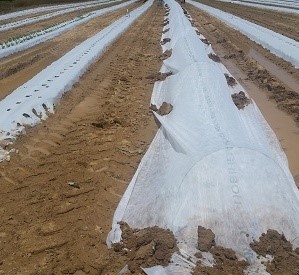
Results from first year (2016) studies as follow:
- Eastern Shore AREC leafy vegetables (Fig. 11). Row cover increased temperature in all three plantings specifically mean and maximum daily temperature. Row cover increased vegetative growth and yield of kale and Swiss chard (Fig. 4) and head weight in lettuce in all three plantings. In the case of lettuce, row cover reduced the time to harvest also. In conclusion, lettuce, kale and Swiss chard can grow during the summer under row cover in Virginia and row cover may improve land use efficiency and sustainability of vegetable farmers and urban agriculture. In addition, the incidence of pest injury in crops under row cover was much less than open field, which may results in less pesticide applications.
- Eastern Shore AREC spring cucumbers (Fig. 12). Row cover increased growth and production of spring cucumbers in the Eastern Shore of Virginia. Temperature increased under the tunnels especially maximum air temperature during the day, but soil temperature at 15 cm deep increased slightly under the row cover. Vine length, leaf area and biomass increased with row cover. Row cover increased total number of fruit and yield by 58% and 45%, respectively. The increase was mainly in the three first harvests. In conclusion, cucumber performed best under row cover and black mulch in spring production and may improve sustainability of vegetable farmers. White mulch affected plant stand, growth and production and is not recommended for early spring cucumber.
- Eastern Shore AREC cucumber (Fig. 13). Row cover increased vegetative growth in cucumber in spring and summer plantings. Although cucumber yield was larger in plots with row cover in the spring planting, the incidence of downy mildew was devastating in the summer and harvest data was unreliable.
On-farm studies with participating farmers. These studies were selected by the participating farmers and reflect their interest in solving their particular problems:
- Lois’s Produce in Westmoreland Co., VA. Row cover shortened the time to first harvest okra. At the time of row cover removal, plants were larger and flowering in comparison to smaller plant in the open field. First and second harvest okra were superior than open field.
- Lawrence and Becky Latane at Blenheim Organic Gardens in Westmoreland Co., VA. In general, they observed reduced insect pressure in summer squash with row cover. Similarly, summer squash under row cover survived a long period of drought before installing the irrigation. Most plants that were not covered were lost. Insect net was used in kale and reduced insect pressure when the net was tight to the ground. Cover crops growing between rows push the netting up, which seems to allow certain insects to reach the crop.
Results of the 2017 season studies.
- Insect netting on flea beetle (Fig. 14). In both 2016 and 2017, the deltaemthrin-incorporated LLINs (either black or yellow) provided the most effective flea beetle control having the fewest numbers of beetles (virtually none) compared with the untreated control plants and also, in some instances, the untreated netting and dinotefuran treatments as well. The treated screen row cover provided control similar to a traditional insecticide control method, without foliar-applied insecticides ever touching the plants. Yield of eggplant and cabbage was highest in the black LLIN row cover and dinotefuran drench treatments, and significantly less in the untreated control plots. Insecticide-incorporated row covers may offer a new and highly-efficacious tool for controlling pestiferous flea beetles on vegetable crops.
- Growth and water use efficiency. Row covers increased air temperature throughout the growing season, but reduced solar radiation and wind, so evapotranspiration in Brussels sprouts was less under row covers in comparison to the open field. Reduced evapotranspiration was associated with less irrigation under the row covers compared to the open field. Row covers increased plant growth, stem length, number of sprouts, and total yield. In conclusion, row covers increased Brussels sprout production and WUE (produce per unit of water applied), which may justify their use to improve the sustainability of vegetable production in water limited areas.
- Growth and nutrient use efficiency. Total fresh weight basil and biomass increased with row cover by 61.0 %, and 73.5% respectively. Fresh weight per plant increased exponentially (R2=0.99) with N fertilization from 832 to 1520 g under row cover, and from 555 to 844 g (R2=0.87) in open field. Although NUE increased with row cover overall and at each fertilization rate, it decreased as the N fertilization rate increased. Height and stem diameter were not different among the fertilization rates. In conclusion, basil under row cover requires more N to optimize growth, and the NUE improves due to the increased vegetative growth in comparison to open field.
On-farm studies with participating farmers. These studies were selected by the participating farmers and reflect their interest in solving their particular problems:
- Bill Jardine at Quail Cove Farm learned that sweetpotato slips can be produced under low tunnels and that requires less labor cost than in high tunnels where he has to replace the soil every year to reduce the incidence of diseases. Low tunnels can be installed and then removed each season to relocate it and allow for rotations.
- Lois’s Produce in Westmoreland Co., VA. Row cover increase growth and shortened the time to first harvest okra. At the time of row cover removal, plants were larger and flowering in comparison to smaller plant in the open field. First and second harvest okra were larger than open field. In the case of summer squash, they did not find difference in growth.
- Lawrence and Becky Latane at Blenheim Organic Gardens in Westmoreland Co., VA. In general, they observed reduced insect pressure in leafy vegetables with row cover and in some instances with insect net (without insecticide). Most likely failure of insect net to protect is due to openings on the sides (not tightly closed to the ground due to intercropping).
- Garner Boyle at Garner’s Produce, found that row cover protected against cucumber beetle and other insect late in the spring, and enhanced growth of the cucumber plants.
Results of the 2018-19 season studies.
- Growth and water use efficiency (journal article published in HortScience). Micro-environmental conditions and Brussel sprouts production changed similar to the 2017 season. Low tunnels increased air temperature, but reduced solar radiation, wind and evapotranspiration. Reduced evapotranspiration was associated with less irrigation under the low tunnels compared to the open field. low tunnels increased plant growth, stem length, number of sprouts, and total yield. In conclusion, low tunnels increased water use efficiency (produce per unit of water applied), which may justify their use to improve the sustainability of vegetable production in water limited areas.
- Growth and nutrient use efficiency (journal article in press, HortScience). Total fresh weight basil and biomass increased under low tunnels. Under low tunnels, plant nitrogen concentration decreased, but total nitrogen uptake increased because of the larger biomass produced. Soil available nitrogen use efficiency (without fertilization) increased under low tunnel, but inconsistent results were obtained on nitrogen fertilizer use efficiency at increasing nitrogen rate. In conclusion, basil under row cover appears to require more N to optimize growth and yield, and the soil available nitrogen use efficiency improves due to the increased vegetative growth in comparison to open field.
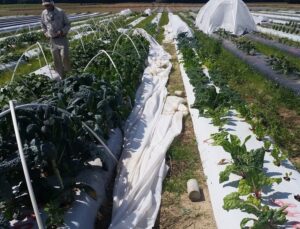
Figure 11. ESAREC, chard and kale. June 2016
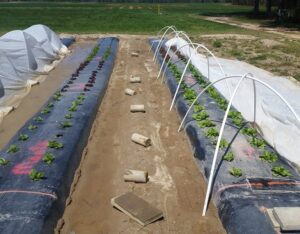
Figure 12. ESAREC, lettuce, April 2016
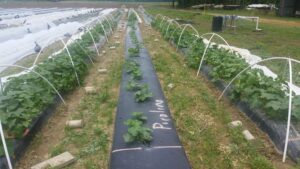
Figure 13. ESAREC, cucumber, May 2016
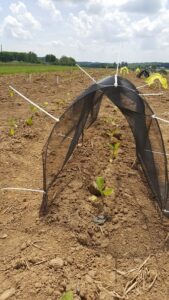
Education
Guest lectures: Row covers and protected production systems. In HORT_4764/5764 Vegetable Crops/Advanced Vegetable Crops (2017 and 2018)
Educational & Outreach Activities
Participation Summary:
Factsheets/educational tools
- Arancibia, R. 2016. Using row covers to improve sustainability of vegetable crop farmers in temperate and tropical climates, p. 26-28. In L. Rutto (Ed.), Proceedings of the 7th National Small Farm Conference. September 20-22, Virginia Beach, VA. http://www.vsu.edu/nationalsmallfarmconference/
- Arancibia, R.A. 2018. Low Tunnels in Vegetable Crops: Beyond Season Extension. VCE extension publication. Pub. HORT-291P. https://pubs.ext.vt.edu/HORT/HORT-291/HORT-291.html
On-farm studies and demonstrations:
- Blenheim Organic Gardens, Westmoreland County, VA. Using low tunnels and insect nets in vegetable crops, On-farm studies to demonstrate the benefits of using row covers and insect nets in an organic production system., 04/04/2016
- Lois’s Produce in Westmoreland Co., VA. Using row cover for early production of okra, On-farm study to improve okra production and earliness, 04/04/2016
- On-Farm Twilight Vegetable Growers Meeting, Miller Farms, 19 Jul 2016.
- Bill Jardine at Quail Cove Farm learned that sweetpotato slips can be produced under low tunnels and that is less expensive than in high tunnels. Low tunnels can be installed and then removed each season to relocate it and allow for rotations.
- Lois’s Produce in Westmoreland Co., VA. Row cover shortened the time to first harvest okra. At the time of row cover removal, plants were larger and flowering in comparison to smaller plant in the open field. First and second harvest okra were superior than open field. In the case of summer squash, they did not find difference in growth.
- Lawrence and Becky Latane at Blenheim Organic Gardens in Westmoreland Co., VA. In general, they observed reduced insect pressure in kale with row cover. However, insect netting (without insecticide) did not protect against flea beetle. Most likely due to openings on the sides (not tight to the ground due to intercropping)
- Garner Boyle at Garner’s Produce, found that row cover protected against cucumber beetle and other insect late in the spring, and enhanced growth of the cucumber plants.
Presentations
- Arancibia, R.A. 2016. Season Extension. In: Virginia market ready TM, Farm to restaurant workshop. Nov. 17, Winchester, VA. Participants: 37
- Arancibia, R.A. 2016. Uso de cubiertas de cultivos para extender la temporada de producción. In: Producción, Mercadeo y Seguridad Sanitaria de Cultivos Hortícolas. Nov. 11, Petersburg, VA. Participants: 14
- Arancibia, R.A. 2016. Season Extension. In: Virginia market ready TM, Farm to restaurant workshop. Nov. 10, Harrisonburg, VA. Participants: 36
- Arancibia, R.A. 2016. Using row covers to improve sustainability of vegetable crop farmers in temperate and tropical climates. 7th National Small Farm Conference. Sept. 20-22, Virginia Beach, VA. Participants: 38 http://www.vsu.edu/nationalsmallfarmconference/NSFCProgram_Sep16.pdf.
- Arancibia, R., & Jenrette, J. (2017). Low tunnels increase vegetative growth and yield, and reduce insect injury in kale and Swiss chard in Virginia. Annual Meeting of the ASHS. HortScience 52(9):S257
- Arancibia, R., & Jenrette, J. (2017). Low tunnels increased vegetative growth in lettuce and shortened the time to harvest in Virginia. Annual Meeting of the SR-ASHS. HortScience 52(9):S40
- Arancibia, R., & Jenrette, J. (2017). Low tunnels increased growth and spring production of cucumbers in Virginia. Annual Meeting of the SR-ASHS. HortScience 52(9):S55
- Arancibia, R., Reiter, M., Rideout, S., Kuhar, T., Romelczyk, S., Deitch, U., and Jenrette, J. (2017). Row cover can improve the sustainability of vegetable farmers and urban agriculture in Virginia. 2017 VCE Professional Development Conference, Blacksburg, VA
- Arancibia, R.A. 2017. Row covers, beyond season extension in vegetable crops. Texas Hispanic small farmer and rancher Conference. September 14 -15, 2017, McAllen, Texas. Attendance = 29
- Arancibia, R.A. 2017. Low tunnels, beyond season extension in vegetable crops. In: 2017 Small Farm Family Conference. Nov. 10-11, 2017, Charlottesville, VA. Attendance = 41
- Acharya, T., G. Welbaum, M. Reiter, and R.A. Arancibia. 2018. Spring and fall production of Brussels sprouts under rowcover in Virginia. HortScience 53: S492
- Arancibia, R.A., T. Kuhar, T. Acharya, J. Jenrette, and H. Doughty. 2018. Reduced insect injury and increased yield of Cole crops and Swiss chard under rowcover in Virginia. HortScience 54: S431.
- Acharya, T. and R.A. Arancibia. 2018. Nitrogen requirement and use efficiency increased for optimal basil production under rowcover compared to open field. HortScience 53: S367
- Acharya, T. and R.A. Arancibia. 2018. Rowcover Reduces Water Requirements and Increases Water Use Efficiency in Spring Production of Brussels Sprouts. HortScience 53: S365
- Nandwani, D., S. Nwosisi, and R. Arancibia. 2018. Integrating row covers into organic production systems for leafy green vegetables. HortScience 53: S257
- Arancibia, R.A., D. Nandwani, and L. Githinji. 2019. Revising and demonstrating the benefits of low tunnels to improve the sustainability of specialty crops farmers and urban agriculture. HortScience 54:S376
- Acharya, T., M. Reiter, G. Welbaum, and R.A. Arancibia. 2019. Nitrogen uptake, growth and production increases in sweet basil grown under low tunnel throughout the summer. HortScience 54:S386
Field days
- Use of row covers and insect nets in vegetable crops. Eastern Shore AREC tour, 7th National Small Farm Conference. Sept. 21, 2016. Painter, VA. Participants: 30
- Protected production systems and drip irrigation in vegetable crops. Eastern Shore AREC tour for young farmers from Bedford County, VA. Aug.13, 2016. Painter, VA. Participants: 21
- Low tunnels and row covers in vegetable crops. Eastern Shore AREC field day. June 6, 2016. Painter, VA. Participants: 40
- Sharing and Networking Meeting, Fauquier Educational Farm, Fauquier County, VA. Jun 23, 2016. Participants: 15
- Arancibia, R.A. 2017. Season extension in specialty crops to improve market supply. In: Virginia market ready TM, Farm to restaurant workshop. Dec. 12, Arlington, VA. Attendance = 24
- Arancibia, R.A. 2017. Season extension in specialty crops to improve market supply. In: Virginia market ready TM, Farm to restaurant workshop. Nov. 30, Wytheville, VA. Attendance = 22
- Arancibia, R.A. 2017. Row covers and low tunnels. In: Fauquier Education Farm 2017 workshop series. Warrenton, VA. Attendance = 15
- Arancibia, R.A. 2017. Protected production systems and the potential for and experiential learning for undergraduate students (field tour for REEL students). June 26, 2017, Eastern Shore AREC, Painter, VA. Attendance = 24
- Arancibia, R.A. 2017. Protected agriculture (low tunnels and row covers) and drip-irrigation in vegetable crops (Field tour to VA Ag. educators). July 19, 2017, Eastern Shore AREC, Painter, VA. Attendance = 120
- Arancibia, R.A. 2017. Protected agriculture (low tunnels and row covers) and drip-irrigation in vegetable crops (Field tour to Tidewater Community College faculty and students). April 21, 2017, Eastern Shore AREC, Painter, VA. Attendance = 13
- Arancibia, R.A. 2017. Protected agriculture (low tunnels and row covers) and drip-irrigation in vegetable crops (Field tour to Master gardeners). April 4, 2017, Eastern Shore AREC, Painter, VA. Attendance = 31
- Nandwani, D. Row cover, 2017 Field tour at the Annual Farm Expo, Tennessee State University. July 20, 2017 Attendance = 11
- Arancibia, R.A. 2018. Row Covers in Vegetables, Beyond Season Extension. Eastern Shore Ag. Conference, Jan. 24-25, Melfa, VA. Attendance = 25
- Arancibia, R.A. 2018. Low tunnels in vegetables: beyond season extension. Northern Neck Vegetable Farmer’s association meeting. Dec. 5, Warsaw, VA. Attendance = 28
Learning Outcomes
Additional benefits of low tunnels/row covers
Project Outcomes
This first year, two participating farmers were unable to complete the study, but are still interested in conducting trials next year. One of them is trying low tunnel/row covers for the first time. The other two participating farmers have good results in their trial and want to repeat the studies next year. A new participant that is conducting tests is the Fauquier Educational Farm in Fauquier Conty, VA.
This project generated and disseminated information about the benefits of integrating low tunnels/row covers into production systems to strengthen the capacity of farmer and urban agriculture to produce vegetable crops more sustainably. Low tunnels modified micro-environmental conditions to favor growth and production, and shorten the production cycle, which may increase land use efficiency and profitability. Considering that low tunnels are more affordable than high tunnels in the short term, an economic advantage can be expected also. Therefore, an increase in economic sustainability is expected by adopting low tunnels into vegetable crops production.
Similarly, low tunnels can improve the environmental sustainability mainly by the following:
- Reduction in pesticide use due to reduction in pest and disease incidences.
- Water conservation due to a reduced irrigation as a result of reduced evapotranspiration.
- It is unclear whether crops under low tunnels/row cover would require more or less nutrients, but the increase in growth and yield suggest an increase in nutrient uptake and use efficiency.
- Low tunnels and row covers are easily movable which facilitates rotations with cover crops. Therefore, incorporating low tunnels into a sustainable production system that uses cover crops may further enhance soil quality and nutrient use efficiency.
Food supply and security are key problems of regional, national and international importance. Strengthening the capacity of specialty crop farmers and urban agriculture to increase production and food supply is expected to increase availability of locally grown fresh and healthy food, and reduce the dependency on distant production areas, therefore, increasing food security in local markets. In addition, availability of healthy fresh food is expected to improve nutrition, health, and the vitality of rural and urban communities (consumer and market system) improving social sustainability. Therefore, this project focused on satisfying human food needs, to enhance environmental quality and the resource base, sustain the economic viability of agriculture, and enhance the quality of life of farmers, farm workers and society as a whole.
In the second year, all four participating farmers completed one or two studies. The new participant at Fauquier Educational Farm conducted several demonstration trial with vegetable crops and organized field tours for farmers in northern Virginia.
This project has generated and disseminated information about the benefits of integrating low tunnels/row covers into production systems to strengthen the capacity of farmer and urban agriculture to produce vegetable crops more sustainably. Low tunnels modified the micro-environmental conditions to favor vegetative growth and production, which resulted in reduced evapotranspiration and irrigation water needs as well as increased water use efficiency. Similarly the increase in growth and yields resulted in an increase in nutrient use efficiency. Faster growth shortened the production cycle and can improved land use efficiency. Increased yield may improve profitability. Similarly, the results of the studies using insect nets impregnated with insecticides indicated the there is potential for this technology to reduce pest incidence and pesticide applications. Therefore, an increase in economic sustainability is expected by adopting row covers into vegetable crops production.
Food supply and security are key problems of regional, national and international importance. Strengthening the capacity of specialty crop farmers and urban agriculture to increase production and food supply is expected to increase availability of locally grown fresh and healthy food, and reduce the dependency on distant production areas, therefore, increasing food security in local markets. In addition, availability of healthy fresh food is expected to improve nutrition, health, and the vitality of rural and urban communities (consumer and market system) improving social sustainability. Therefore, this project focused on satisfying human food needs, to enhance environmental quality and the resource base, sustain the economic viability of agriculture, and enhance the quality of life of farmers, farm workers and society as a whole.
In 2018-19, two experiments on water use efficiency and nitrogen use efficiency were completed, data analyzed, and two journal articles were published (one in press). in addition, an extension article was published. Additional conference presentations and stakeholders workshops were conducted (see presentations).
The main conclusions of these studies were:
- Water conservation due to a reduced irrigation and increased water use efficiency as a result of reduced evapotranspiration under low tunnels despite the increased temperature.
- Increase in vegetative growth resulted in increased nutrient uptake, so data suggest that optimal fertilization for basil production under low tunnels is slightly higher than open field.
- Nonetheless, soil available nitrogen use efficiency increased due to increased basil vegetative growth and yield.
This project demonstrated additional benefits of using low tunnels covered with spun-bonded row cover in production of specialty crops. Therefore, to demonstrate the impact on sustainability, assessment should include all benefits (yield increased, reduced irrigation and water use efficiency, fertilization and use efficiency, reduction of pests infestation and injury, etc).